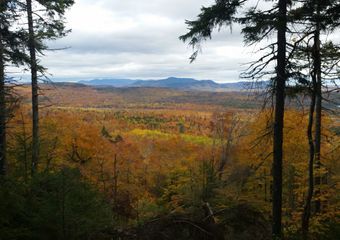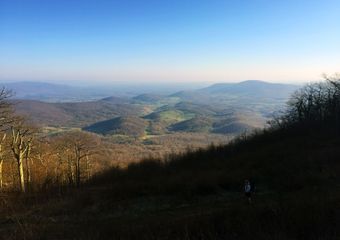Mailbag with Jennifer Pharr Davis: 7 Tips for Finding Solitude on the Appalachian Trail
The Trek Editor’s Note
Welcome to Mailbag with Jennifer Pharr Davis, where we take hikers’ questions and pass them off to the trail legend for her wisdom and analysis. JPD’s newest book, The Pursuit of Endurance is available now, and you can catch her upcoming book tour over the next few weeks in Hanover NH, Colby College, Portland ME, Dover NH, and Concord NH.
Have a question for an upcoming Mailbag? Email [email protected] and we’ll pass it on. If your question is chosen for our next Mailbag, we’ll send you a signed copy of JPD’s newest book.
Question:
How do I avoid the crowds during an AT thru-hike? –Buckets, AT 2016
The most common complaint on the Appalachian Trail these days is that the path is too crowded. But when I spend two hours hiking one mile with my kids—and bribing my daughter with M&Ms—we often don’t see many, if any, other hikers.
Then I went to Trail Days in Damascus, Virginia. I went out for a short trail run and passed 20-30 hikers who were headed into town to enjoy the festivities. I’ve been accessing different parts of the AT between North Carolina and Maine for the past six weeks and this was the first time the path felt busy or crowded.
In my experience, it is not difficult to find solitude on the trail if you are a day hiker or section hiker, but for thru-hikers, it has become challenging to find time alone and avoid large groups—challenging… but not impossible. Here are a few tips for avoiding the bubble, and suggestions for finding solitude inside of it.
1) Start Late
When NOBOs start early to avoid the crowds, snow and bad weather cause delays and force hikers to hole up in town. These hikers spend more money, more time off trail, and the bubble either catches them like the 1988 movie The Blob or they spend the rest of the trail stressed about staying ahead of it. If you leave May 1st, most thru-hikers will have quit by the time you hit the mid-Atlantic and a five-month thru-hike will still put you on top of Katahdin at the end of September.
2) Opt for a Flip-Flop
The ATC is really pushing this approach these days. and with good reason. A flip-flop allows hikers to start at a midway point on the trail and avoid the high numbers at either terminus. This also allows for a longer weather window. Katahdin is the only mountain on the trail with a regulated end date. Want more time? Start in the middle and hike south, then head to Katahdin in early August and connect the dots. Finishing in November gives you a relatively comfortable eight-month window.
3) Try a “Seasonally Alternative” Thru-Hike
Recently there are have been more hikers looking to experience a thru-hike outside of the norm. Hikers like the Hiking Viking show us the upside of freezing your butt off on a winter thru-hike to cut tracks through fresh and embrace the beauty, softness and silence of a winter hike. I can personally testify to the transformative power of pouring buckets of sweat to explore the trail (and your endurance) during your summer “vacation.” If you decide to hike outside of the “normal” season, keep in mind there are more intensive preparations you’ll need to take.
4) Hike Early and Hike Late
Even within the bubble there are hours of solitude to be found on the trail. Want some alone time in the midst of the herd? Get up at 6am and start walking. You’ll pass tents, but you probably won’t see your first hiker on trail until 9m. Likewise, 6-9pm is a great time to catch some solitude, more wildlife sightings, and watch the sunset from the trail.
5) Avoid Shelters
It’s not always possible to follow regulations and avoid lean-tos, but for most of the trail there are small one or two-person campsite options between larger group campsites. You may not have the amenities of a privy, bear cable, or nearby water source, but you also won’t be kept up all night by snoring at a solo campsite.
6) Hike in Bad Weather
Want the trail to yourself? Walk through the rain, sleet, and snow. It is amazing how many hikers disappear in inclement weather.
7) Be Honest About Your Needs
The Appalachian Trail is a trail and a community. An integral part of the AT experience comes from listening to, engaging, and sharing with other hikers. But if you hit a point where you just need to do you, you need to be willing to communicate that to other hikers. It isn’t wrong or rude to tell your trail friends that you want to spend a few miles walking alone. Learning how to say “I was really hoping to spend some time alone on the trail today,” can help create space and boundaries even in the heart of the bubble.

The folks I meet who complain the most about crowds have either hiked less popular long-distance trails or they have a longterm relationship with the AT. It’s important to remember that the Appalachian Trail is different than it was five years ago, let alone 10, 20, 30 years in the past. Instead of comparing the trail to how it used to be, it is important to also recognize the positive aspects of the trail’s growth and evolution. From the standpoint of advocacy, funding, trail maintenance, and public health, more hikers are better than no hikers. Plus, it’s a lot easier to embrace the increase in fellow backpackers when you have strategies and tools to find solitude.
Related
This website contains affiliate links, which means The Trek may receive a percentage of any product or service you purchase using the links in the articles or advertisements. The buyer pays the same price as they would otherwise, and your purchase helps to support The Trek's ongoing goal to serve you quality backpacking advice and information. Thanks for your support!
To learn more, please visit the About This Site page.










